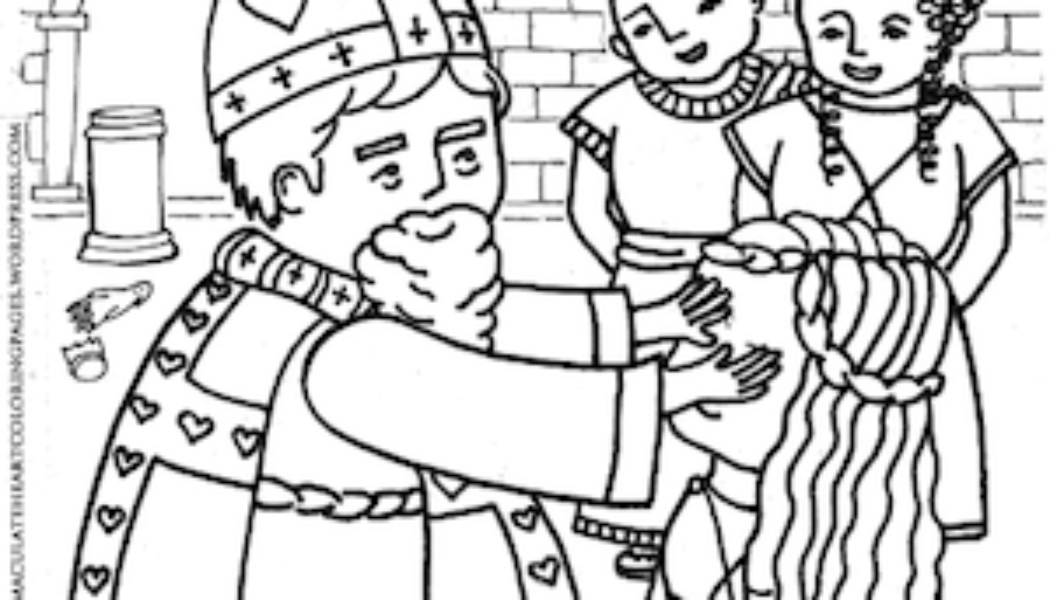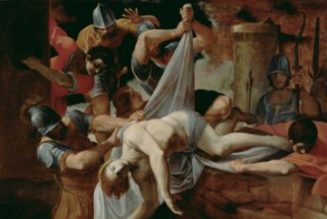Hey everybody,
Tuesday is February 14, and you’re reading The Tuesday Pillar Post.
First, a bit of a mea culpa. I told you last week about St. Apollonia, an Egyptian martyr who died after suffering some dental distress – and I told you that last Tuesday was the customary date of her feast. I was wrong.
See, I knew that St. Apollonia’s feast was February 9, and I thought last Tuesday was February 9. It wasn’t. It was February 7, and I spent the whole day thinking it was the wrong date.
I now feel pretty silly about that, but I figured I should own it, rather than pretend that embarrassing faux pas never happened — especially since Ed brought it to your attention in his Friday newsletter. What are friends for, right?
Unlike last week, I am absolutely confident that I know the date today, and what saint is customarily observed today.
It’s the feast of Sts. Cyril and Methodius, of course!
But we’re not going to talk about them right now. Because – while he’s not the memorial on the universal calendar today – I have some cute little cards from my kids telling me that today is St. Valentine’s Day.
There are a lot of hagiographies about St. Valentine himself, and competing accounts, so here’s just one version of the man:
Valentine was, by some accounts, a third-century bishop who was frequently subject to persecution for his fervent preaching of the Gospel.
One popular story says that Valentine was once under arrest in the residence of a Roman judge, and that Valentine began preaching the Gospel to his captor.
The story says that the judge – named Asterius – brought to Valentine his blind daughter, apparently telling the bishop that if Valentine prayed over the girl and she was restored to sight, he would do whatever the bishop asked of him.
Well, Valentine did pray over the girl, and she was restored to sight. But Valentine, rather than ask to be set free, asked the judge to smash all the idols in his house, to fast for three days, and then to be baptized.
The judge reportedly did exactly that, becoming a Christian, and then freeing Valentine and a number of other Christians under arrest. But Valentine was, according to most accounts, arrested again, and executed outside the city of Rome.
One story – which seems to have emerged many, many centuries later – is that before he was martyred, the bishop dashed off a quick note of encouragement to Asterius’ daughter, and that he signed the note “Your Valentine” — thus launching the romantic custom.
Another story says that Valentine witnessed the marriages of several Christian couples who were themselves also waiting for execution.
It is not clear, of course, whether he gave them those little candy hearts with words first.
Of course, because my kids needed Valentines to give to their classmates, I had hoped to find some of that martyrology on little cards or candy hearts. We struck out on that effort.
But we did come across this cool coloring page, which actually depicts a pretty good amount of the Valentine story — note the broken idols in the background:
I would caution, before we get to the news, that you be careful with St. Valentine’s Day — one never knows when giving a Valentine might give someone the wrong idea, like it did for poor Ralph Wiggum:
May St. Valentine intercede for us. And a bit more on him later.
The news
If you want to talk today about extraordinary love, Nicaraguan Bishop Rolando Álvarez is a very good place to start.
The Pillar has been covering for months the persecution of Christians by the regime of President Daniel Ortega in Nicaragua. You probably remember this summer, when a parish rectory went under siege, because the parish pastor refused to hand over radio equipment, used to broadcast the faith, and a message about human dignity, to a broad region of rural villages.
You might remember that when its bishop spoke out, he was detained in his rectory and accused of inciting violence, and then arrested.
And you might even remember before any of that, our Latin American correspondent told you about the Nicaraguan bishop who was fasting for an end to persecution in his diocese, and in the country.
That bishop was Álvarez, who was sentenced to 26 years in prison on Friday, for “inciting rebellion against the government,” a charge which stemmed from his insistence on, you know, proclaiming the Kingdom.
One element of the story is perhaps most extraordinary: Álvarez was offered the chance, repeatedly, to be exiled from Nicaragua the day before he was sentenced to prison. He declined, insisting that he would stay in his homeland, while 222 other political prisoners were sent to the U.S.
For the temerity to stay close to his people, Álvarez was very soon whisked off to prison.
Of course, he predicted that.
In our first story about Bishop Álvarez, we told you his response when a Matagalpa cathedral parishioner was beaten by a mob of Ortega sympathizers.
“Don’t do with the faithful what you want to do with me. Do with me what you want, but not with the faithful – not with God’s holy people,” Álvarez said publicly.
The police listened. As the bishop resisted an autocratic, anti-Catholic dictator, police cracked down on him, and the persecution didn’t stop.
And as Bishop Álvarez now prepares for the prospect of almost three decades behind bars, our sources in Nicaragua say he has perdured in faith, hope, and – this is extraordinary – in joy.
Read about Bishop Álvarez, and then pray for him, if you would.
—
Meanwhile, as the continental phase of the synod on synodality continues, our data supremo Brendan Hodge continues to use data-driven textual analysis to see what can be gleaned about the drafting of the Church’s synod documents.
Brendan fed into a textual analysis program the 18 national synod documents published in English, along with the “Working Document for the Continental Stage” published last year by the Holy See. And he looked to find patterns in the frequency and context of language — to see what texts actually influenced the Holy See’s “Working Document.”
Of course, data-driven textual analysis can find patterns, frequency relationships, and correlations, but it’s not a perfect kind of science. Still, from a textual perspective, we learned some things – and we found that the Holy See’s “Working Document” has different emphases than any of the published national texts.
Look, there is a lot of opinion-writing on the synod on synodality, some good, most predictable rage-bait trafficking in clicks.
We’re taking a different approach — aiming for a concrete look at what can be learned about how the synod is actually going.
Brendan’s work is unparalleled, and always worth reading. I’m proud to have it at The Pillar.
But at its conclusion, the meeting of European bishops, clerics, religious, and laity did read a draft text of “final remarks,” which said that the meeting had been transformational:
“Throughout the days of the assembly, we went through a form of Pentecost, which for the first time led us to experience that it is possible to meet, listen to each other, and dialogue, starting from our differences and beyond the many obstacles, walls, and barriers that our history puts in our way.”
A “form of Pentecost,” in which, for “the first time,” people met, listened, and talked with one other.
Just one quick comment: I’m not sure you can say something is novel — experienced for the first time — if you also compare it to a historical event, Pentecost.
I mean, after all, the comparison itself depends on the fact of the historical event to make any sense.
Maybe, by “we,” the participants didn’t mean the Church, but themselves — that it was the first time THEY had meetings and conversations with people who disagree with them. If so … that’s really too bad, isn’t it?
If you were perplexed too, there is some reassuring news, with a kind of whimsy which captures the spirit of the synodality synod, I think: The initial draft text of the “final remarks” were only preliminary final remarks, and not actually final final remarks.
The draft final section of the final remarks, containing the Pentecost reference, was cut from the final version of the final remarks of the synodal assembly of the synod on synodality.
🙂
—
A Portuguese report published Monday estimated there have been close to 5,000 victims of clerical abuse of minors in the country since 1950.
As with reports published in other countries, the report says that most of the documented instances of abuse took place decades ago, and the bishops’ conference emphasized its profound regret and sorrow.
The report did have some unique elements. First, 47% of alleged victims were female — a significantly higher proportion than in other places.
Second, the report emphasized that Portugal does not have a culture or expectation of financial compensation after abuse — most alleged victims surveyed in a study said what they wanted most was a sincere apology, to see their abuser laicized, and some help for psychological or medical needs.
—
Meanwhile, in the United States, Cardinal Robert McElroy of San Diego announced last week that his diocese is likely facing the prospect of bankruptcy, in response to more than 400 abuse-related lawsuits filed against the diocese in the last three years.
In an analysis, Ed looks at the practice of declaring diocesan bankruptcy — asking if alternative mediation and compensation models can be of more help to victims, and noting that the Holy See has urged U.S. bishops to proceed very slowly with bankruptcy.
So what might that mean for San Diego? Ed has some thoughts about the question, right here.
—
OK, we have been reporting in recent weeks a set of allegations made against laicized priest Frank Pavone, director of Priests for Life.
Will that happen? So far, Pavone and Priests for Life are circling the wagons. But we’ll see what comes next.
And before we leave Pavone, I’d just offer a brief reflection I’ve been praying with.
Reporting on abuse and misconduct in the life of the Church is important because it helps to bring to the fore issues in need of healing, forgiveness, and reconciliation — in need of justice, to be clear. It also helps to catalyze ecclesial reform – I hope – or at least to identify the areas in Church life in which serious reform is needed.
We do that kind of reporting because we believe those things matter, and they help the Church to better pursue her sacred mission, and to allow for faith, grace, and the charisms of the Holy Spirit to better animate the lives of Christians, for the salvation of souls and the glory of God.
But these kinds of stories are often a visit to the sorrow of fellow Christians – to the painful experiences they’ve had, which have often been a stumbling block to their faith, and to their hope.
I think there’s value for us to see that sorrow, to enter it, even just for a moment, in a kind of solidarity with the grief or anguish that a fellow believer is experiencing. We can use that solidarity to pray for a suffering person, of course, and we can often detect in their lives a witness of extraordinary grace at the foot of Calvary.
But solidarity with people who are suffering requires, I think, that we learn how to find the Lord in the sorrow, find hope in the anguish — that we trust in God’s providential goodness, and that when we witness suffering, we let it bring us closer to the Cross, and to the Crucified One, instead of allowing it to draw us further away.
Christians plunge into suffering, we don’t run away from it, because we know that the Lord hung on a cross, and thus every depth of human anguish is a place where Christ can be found. We also know that he, in the profound mystery of the Cross, redeems our suffering — that from the Cross, he is resurrected and glorified, and from the Cross, he makes saints.
If we don’t know those things, or if we lose sight of them, entering the sorrow of other people, or even acknowledging our own, is a path of danger, in which we might find ourselves grasping at all the wrong things, to make the sorrow go away.
That’s often sin, right? — grasping for something that takes us out of the Christian meaning of a moment’s reality. Grasping for something easier, more pleasurable, more subject to our control.
But if we bring that sorrow to the Cross, instead, God sometimes gives a glimpse of the profundity of his love, and the depth of his enduring mercy.
I’ll be thinking about sorrow, and redemption, and the cross in the weeks to come, as we prepare for Lent. I hope that in suffering, each of us finds the gentle, enduring goodness of our crucified and suffering Lord – and his redemption.
Valentine’s heart
Finally, I told my kids this morning that St. Valentine’s heart can be found in a box, under an altar, at the Whitefriar Street Carmelite Church in Dublin.
They had no trouble believing that St. Valentine prayed, and a little girl could see. They had no problem accepting that her father and his household were baptized. They got excited for the part where Valentine sent the girl a little Valentine.
But they refused to accept that Valentine’s heart is in a reliquary in Dublin.
But according to Pope Gregory XVI, who gifted some of Valentine’s relics to the Dublin Carmelites, that’s where it is.
After Gregory heard in 1835 a Carmelite preacher named John Spratt in Rome, he decided to give the friar’s church a gift. Relics of St. Valentine arrived in Dublin in 1836, were solemnly processed to Whitefriar street, and installed byArchbishop Murray in the Church.
But guess what? Valentine’s Day wasn’t really popular then. People forgot about the relics. They went into storage, in fact.
It wasn’t until a major church renovation in the 1950s and 1960 that anyone remembered them, and a little altar was constructed for their veneration. Irish couples – and American honeymooners, probably – now go to the altar to ask St. Valentine to pray for their unions.
Better, perhaps, to ask St. Valentine for good sight. He’s got a long track record of success on that one.
Happy day.
Please be assured of our prayers, and please pray for us. We need it.
Yours in Christ,
JD Flynn
editor-in-chief
The Pillar







